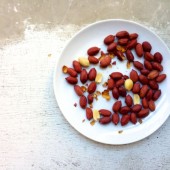
8 months ago I started this blog with the intention of covering a food-related topic that hits close to home. Today, I’m finally getting the chance to share it.
As many of you know, in this country, and around the world, we’re facing an epidemic; a serious, and growing public health concern. Food allergies are on the rise, touching millions of families worldwide.
A few facts to consider:
- Up to 15 million Americans have food allergies, which affects every 1/13 children
- There are 200,000 emergency room visits each year due to exposure to food allergens
- A CDC study conducted in 2008, discovered an 18% increase in food allergies over the previous 10-year period.
The situation is grim, and it’s getting worse.
Theories abound, including the hygiene hypothesis, which suggests that we’ve become too clean and our immune systems are sitting around idle, waiting to attack, something, anything, even if it’s harmless.
Eight foods account for 90 percent of all reactions: milk, eggs, peanuts, tree nuts, soy, wheat, fish and shellfish.
Lauren, who started First Grade this year, has an anaphylactic reaction to two of them (peanuts and tree nuts) as well as third: sesame.
When Lauren was first diagnosed with her food allergies, I was worried. I thought about the years to come: how could I send her to school? On play dates? To summer camp? I loaded up on Epipens and stashed them around the house, in diaper bags, and in the bottom of the stroller. I threw out any offending substances – the Tahini paste in the fridge, the nuts in my freezer, and the jars of sesame seeds and Asian sauces in my cupboard.
But even with all of that vigilance, you can never fully protect your kids.
A few months after Lauren turned 2 we had our first allergic episode. A guest had brought peanut butter Easter eggs to a dinner party we hosted for my husband’s birthday. Somehow, over the course of the evening, they’d gotten mixed into the bowl of solid milk chocolate eggs that I was planning to hide the next morning.
When Lauren woke up, she was thrilled to find that the Easter bunny had visited. She quickly uncovered the eggs from their hiding spots, unwrapped the first, and bit into it.
I didn’t realize the mistake until Lauren was halfway through her egg and I noticed that the center looked different from the shell.
I tried the remaining half and was horrified when I tasted peanut butter. Panic set in and I watched her with a close eye.
She seemed to be a little uncomfortable, but nothing happened in the first half hour. I was starting to think that her skin test was a false positive when she started to cough and wheeze. Slowly at first, but progressively it got worse. She quickly got to a point where she was gasping for air and I realized that we were dealing with an anaphylactic reaction. Because of the slow onset, I’d been taken off guard – this wasn’t how I’d expected anaphylaxis to unfold.
I dug through the diaper bag with shaky hands and found the Epipen. After tearing off the blue top, I grabbed a fistful of skin and injected it into her thigh. She responded immediately. The coughing and wheezing stopped. She was back to her normal 2-year old self, laughing and chatting about the Easter bunny. Stunned, we packed a bag, strapped her into the stroller, and took her straight to the hospital.
As terrifying as our experience was, I learned a valuable lesson. That the Epipen is not to be feared, that it’s there for emergency situations, and that it works. I gained confidence in my ability to handle a similar situation, God forbid it were to ever happen again.
continue reading
 Lauren showed me a pen right before Valentine’s day. “Look mom, it says ‘Buckeyes’”.
Lauren showed me a pen right before Valentine’s day. “Look mom, it says ‘Buckeyes’”.








